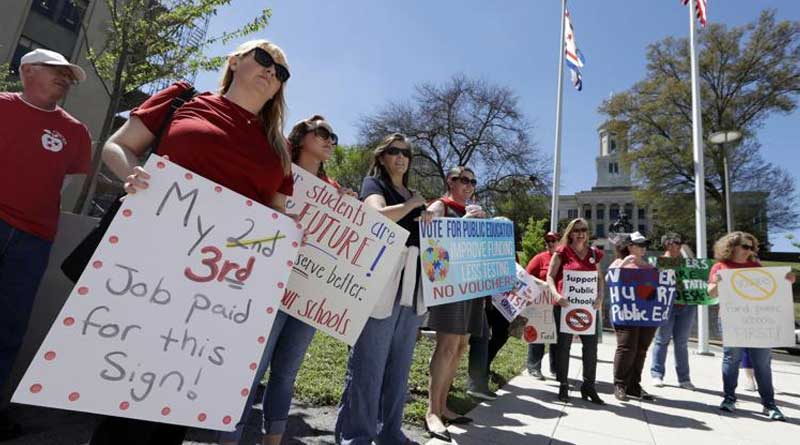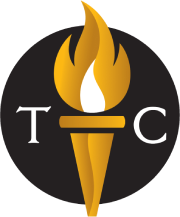Photo: People protest against school vouchers Tuesday, April 9, 2019, in Nashville, Tenn.
Photo Credit: Mark Humphrey / AP
The Center Square [By Vivian Jones]-
Metro Nashville Public Schools and Shelby County Schools could net $500 and $2,000, respectively, in savings per participating student if Tennessee’s school-choice program were to be implemented, new research shows.
Analysis from the Beacon Center of Tennessee shows the two districts where Tennessee’s Education Savings Accounts (ESA) Pilot Program would be implemented would save significantly in per-pupil spending for each year of the program. That savings would come in addition to grants from the state for the full cost of each ESA awarded that both districts would receive from the state for the first three years.
Currently in a legal battle in which Beacon has intervened, the ESA program would provide state-funded scholarships of about $7,000 to low-income students in Davidson and Shelby counties to enable them to attend private or alternative schools of their choice.
Local and appeals courts have sided with the school districts regarding the program’s constitutionality, and an appeal to the Tennessee Supreme Court is imminent. Central to Metro Nashville and Shelby County’s legal challenge to the ESA program is the claim by both districts that the program would cause financial harm to the districts.
“ESAs benefit everybody. The students who aren’t best served by the public schools who choose to utilize an ESA end up getting a more customized educational experience that fits their needs, and for the vast majority of students who are well served by the public school system, what they’re getting is more funding and resources per student,” said Ron Shultis, director of policy and research at Beacon.
To calculate savings to the districts, Beacon analysts estimated the fiscal impact of Tennessee’s ESA program on both districts where it would be implemented, and calculated average participation rates and costs associated with the program.
Even though Shelby County spends nearly $13,000 per student each year, and Metro Nashville spends more than $16,000 per student annually, the law states an ESA award may not exceed the average total state and local spending per-student statewide. According to the state comptroller, that statewide average was $7,376 in 2018-2019.
According to the report, Shelby County Schools receives about $5,900 in state funding and about $2,600 in local funding per student through the Basic Education Program. The district also receives federal funding, and local option dollars from county, city and special district revenue. Subtracting the maximum amount of an ESA, Shelby County would retain more than $5,200 per ESA student, per year.
“Obviously, some of those funds will have to go to pay for fixed costs that the school is going to have to pay for, regardless of whether or not the student attends or not,” Shultis said.
Beacon estimates that even after paying for fixed costs such as instruction, food services and student support, Shelby County Schools would retain more than $2,000 per student per year if the program was implemented.
Metro Nashville, meanwhile, receives more than $3,600 per student in state funds, and about $4,500 per student in local funds through the Basic Education Program, in addition to local option dollars and federal funds totaling more than $5,600 per student per year. Subtracting the cost of an ESA, Metro Nashville would retain nearly $6,500 per student per year if the ESA program was implemented. After subtracting estimated fixed costs, the district would save more than $500 per student.
“You’re left with, essentially, a windfall of savings for the district that then they can use for new classroom supplies, higher salaries for teachers, or more teachers to even further reduce classroom size,” Shultis said.
If implemented, a maximum of 5,000 students could receive an ESA in the program’s first year, with an additional 2,500 students added for each year if a demand threshold is met. If the maximum number of students allowed actually participated in the ESA program over the course of the five-year pilot, Shelby County Schools could see a total savings of nearly $18 million, while Metro Nashville could see more than $3 million in savings, Beacon estimates.
In addition to these savings, both districts also would receive direct grants from the state in the amount of each ESA awarded in the district for the first three years of the program. Those grants would amount to more than $7,000 per student in additional funds.
In response to the Beacon Center report, Metro Nashville Public Schools released the following statement:
“It is plainly evident and affirmed by two courts that the voucher law, passed under questionable circumstances, is unconstitutional and a targeted attack on Metro Nashville and Shelby County Schools. We appreciate the work of the Metro Legal Department to have this ill-advised law struck down, and hope the State of Tennessee declines to pursue further appeals and focuses instead on supporting public schools.”
Shelby County Schools did not respond to a request for comment.




